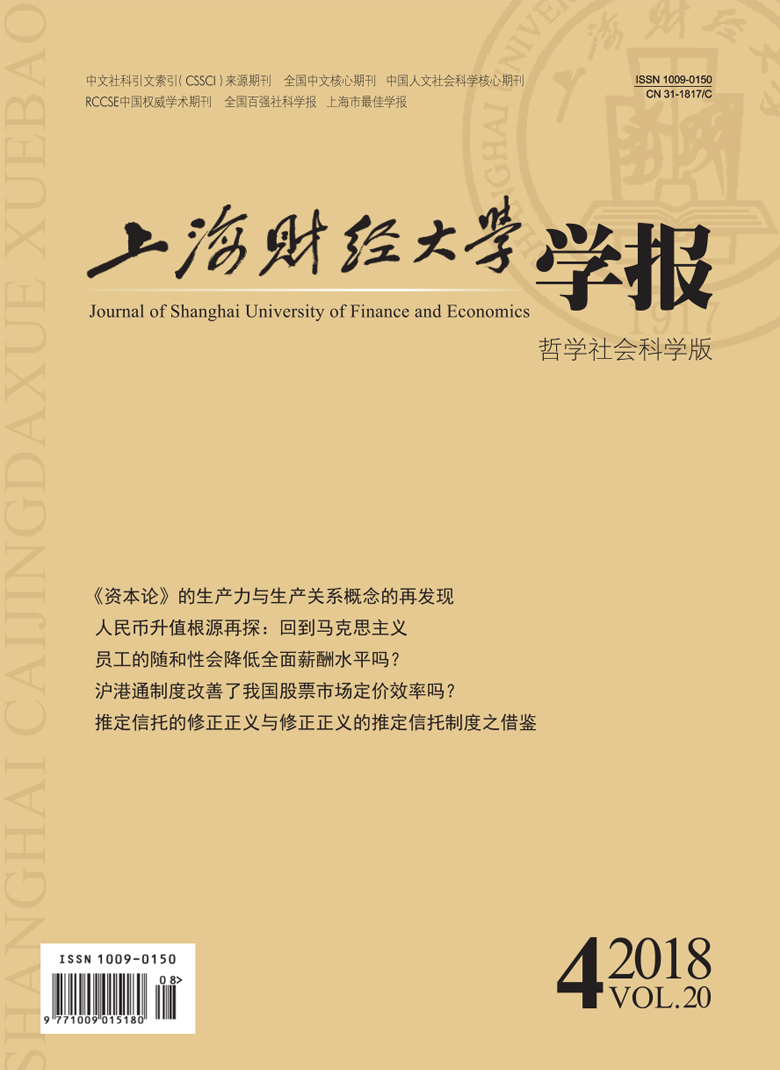围绕员工的随和性与全面薪酬水平的关系,文章结合中国文化和管理实际,利用NEO-PIR量表和美国薪酬协会对全面薪酬的界定设计调查问卷,以中国境内包含国有企业、民营企业等在内的1 486名各类员工为样本进行问卷调查,在信度和效度分析的基础上,利用相关和多元回归分析对数据进行统计分析。结果表明,随和性会降低员工全面薪酬水平,但区别于西方组织情境,中国组织情境下员工随和性与薪酬不完全负相关,随和性与货币报酬负相关,与福利不具有相关性,与学习和发展负相关,与工作环境正相关;谦虚、利他和慈善是影响货币报酬的重要因素;顺从、坦诚和利他是影响非货币报酬的决定性变量。因此,企业应有效发挥不同人格特质员工的优势,真正做到“让雷锋不吃亏”。
员工的随和性会降低全面薪酬水平吗?——来自中国文化与组织情境下的实证检验
摘要
参考文献
6 李燕萍, 徐嘉. 基于组织认同中介作用的集体主义对工作幸福感的多层次影响研究[J]. 管理学报, 2014, (2).
13 Allport G W. Personality: A psychological interpretation[M]. New York: Henry Holt Later Printing, 1937.
14 Barrick M R, Mount M K. The big five personality dimensions and job performance: A meta‐analysis[J]. Personnel Psychology, 1991, 44(1): 1–26. DOI:10.1111/peps.1991.44.issue-1
15 Barrick M R, Stewart G L, Piotrowski M. Personality and job performance: Test of the mediating effects of motivation among sales representatives[J]. Journal of Applied Psychology, 2002, 87(1): 43–51. DOI:10.1037/0021-9010.87.1.43
16 Barry B, Friedman R A. Bargainer characteristics in distributive and integrative negotiation[J]. Journal of Personality and Social Psychology, 1998, 74(2): 345–359. DOI:10.1037/0022-3514.74.2.345
17 Benyus J M, Bremmer I, Christakis N A, et al. Breakthrough ideas for 2009[J]. Harvard Business Review, 2009, 87(2): 19–40. (未找到本条文献信息, 请核对)
18 Blickle G, Meurs J A, Zettler I, et al. Personality, political skill, and job performance[J]. Journal of Vocational Behavior, 2008, 72(3): 377–387. DOI:10.1016/j.jvb.2007.11.008
19 Bozionelos N. Mentoring provided: Relation to mentor’s career success, personality, and mentoring received[J]. Journal of Vocational Behavior, 2004, 64(1): 24–46. DOI:10.1016/S0001-8791(03)00033-2
22 Costa P T, McCrae R R.NEO PI-R professional manual[M]. Odessa: Psychological Assessment Resources, 1992.
23 Digman J M. Personality structure: Emergence of the five-factor model[J]. Annual Review of Psychology, 1990, 41(1): 417–440. DOI:10.1146/annurev.ps.41.020190.002221
24 Fernandes F N. Total reward-an actuarial perspective[N]. Actuarial Research Paper, 1998-08-11(6).
25 Gelissen J, De Graaf P M. Personality, social background, and occupational career success[J]. Social Science Research, 2006, 35(3): 702–726. DOI:10.1016/j.ssresearch.2005.06.005
26 Goldberg L R. An alternative" description of personality": The big-five factor structure[J]. Journal of Personality and Social Psychology, 1990, 59(6): 1216–1229. DOI:10.1037/0022-3514.59.6.1216
27 Goldberg L R. The development of markers for the big-five factor structure[J]. Psychological Assessment, 1992, 4(1): 26–42. DOI:10.1037/1040-3590.4.1.26
28 Heineck G. Does it pay to be nice? Personality and earnings in the United Kingdom[J]. ILR Review, 2011, 64(5): 1020–1038. DOI:10.1177/001979391106400509
29 Hogan J, Holland B. Using theory to evaluate personality and job-performance relations: A socioanalytic perspective[J]. Journal of Applied Psychology, 2003, 88(1): 100–112. DOI:10.1037/0021-9010.88.1.100
31 Ilies R, Scott B A, Judge T A. The interactive effects of personal traits and experienced states on intraindividual patterns of citizenship behavior[J]. Academy of Management Journal, 2006, 49(3): 561–575. DOI:10.5465/amj.2006.21794672
32 John O P, Srivastava S. The big-five trait taxonomy: History, measurement, and theoretical perspectives[A]. Pervin L A, John O P. Handbook of personality: Theory and research[C]. New York: Guilford Press, 1999: 102–138.
33 Judge T A, Higgins C A, Thoresen C J, et al. The big five personality traits, general mental ability, and career success across the life span[J]. Personnel Psychology, 1999, 52(3): 621–652. DOI:10.1111/peps.1999.52.issue-3
34 Judge T A, Heller D, Mount M K. Five-factor model of personality and job satisfaction: A meta-analysis[J]. Journal of Applied Psychology, 2002, 87(3): 530–541. DOI:10.1037/0021-9010.87.3.530
35 Judge T A, Livingston B A, Hurst C. Do nice guys-and gals-really finish last? The joint effects of sex and agreeableness on income[J]. Journal of Personality and Social Psychology, 2012, 102(2): 390–407. DOI:10.1037/a0026021
36 LePine J A, Van Dyne L. Predicting voice behavior in work groups[J]. Journal of Applied Psychology, 1998, 83(6): 853–868. DOI:10.1037/0021-9010.83.6.853
37 Liu L A, Friedman R A, Chi S C. ‘Ren Qing’ versus the ‘Big Five’: The role of culturally sensitive measures of individual difference in distributive negotiations[J]. Management and Organization Review, 2005, 1(2): 225–247. DOI:10.1111/j.1740-8784.2005.00010.x
38 Lounsbury J W, Gibson L W. Personal style inventory: A work-based personality measurement system[M]. Knoxville: Resource Associates, 2002.
40 Manas T M, Graham M D. Creating a total rewards strategy: A toolkit for designing business-based plans[M]. New York: American Management Association, 2003.
41 McCrae R R, Costa P T. The structure of interpersonal traits: Wiggins's circumplex and the five-factor model[J]. Journal of Personality and Social Psychology, 1989, 56(4): 586–595. DOI:10.1037/0022-3514.56.4.586
42 Morgeson F P, Reider M H, Campion M A. Selecting individuals in team settings: The importance of social skills, personality characteristics, and teamwork knowledge[J]. Personnel Psychology, 2005, 58(3): 583–611. DOI:10.1111/peps.2005.58.issue-3
43 Mount M K, Barrick M R, Stewart G L. Five-factor model of personality and performance in jobs involving interpersonal interactions[J]. Human Performance, 1998, 11(2-3): 145–165. DOI:10.1080/08959285.1998.9668029
44 Mueller G, Plug E, Mueller G. Estimating the effect of personality on male and female earnings[J]. ILR Review, 2006, 60(1): 3–22. DOI:10.1177/001979390606000101
45 Ng T W H, Eby L T, Sorensen K L, et al. Predictors of objective and subjective career success: A meta‐analysis[J]. Personnel Psychology, 2005, 58(2): 367–408. DOI:10.1111/peps.2005.58.issue-2
46 Paulhus D L, Trapnell P D. Self-presentation of personality: An agency-communion framework[A]. John O P, Robins R W, Pervin L A. Handbook of personality: Theory and research[C]. New York: Guilford Press, 2008: 492–517.
47 Rode J C, Arthaud-Day M L, Mooney C H, et al. Ability and personality predictors of salary, perceived job success, and perceived career success in the initial career stage[J]. International Journal of Selection and Assessment, 2008, 16(3): 292–299. DOI:10.1111/ijsa.2008.16.issue-3
48 Saucier G. Mini-markers: A brief version of Goldberg’s unipolar Big-Five markers[J]. Journal of Personality Assessment, 1994, 63(3): 506–516. DOI:10.1207/s15327752jpa6303_8
49 Spurk D, Abele A E. Who earns more and why? A multiple mediation model from personality to salary[J]. Journal of Business and Psychology, 2011, 26(1): 87–103. DOI:10.1007/s10869-010-9184-3
50 Tasa K, Sears G J, Schat A C H. Personality and teamwork behavior in context: The cross‐level moderating role of collective efficacy[J]. Journal of Organizational Behavior, 2011, 32(1): 65–85. DOI:10.1002/job.680
51 Wiggins J S, Trapnell P D. A dyadic-interactional perspective on the five-factor model[A]. Wiggins J S. The five-factor model of personality: Theoretical perspectives[C]. New York: Guilford Press, 1996: 88–162.
引用本文
谭春平, 景颖, 王烨. 员工的随和性会降低全面薪酬水平吗?——来自中国文化与组织情境下的实证检验[J]. 上海财经大学学报, 2018, 20(4): 63-77.
导出参考文献,格式为:





 , 1
, 1 25432
25432  17904
17904

